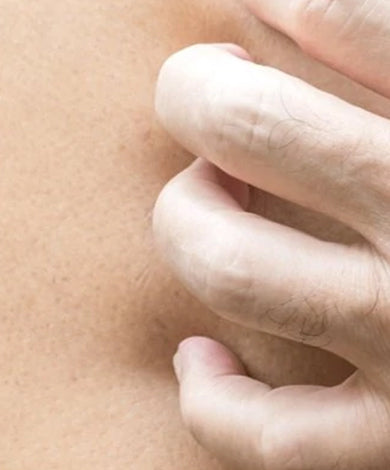Secret Santa Sale – Get Up to 30% Off + Exclusive Pouch & Gloves on min spend of Rs. 1999/-
Free shipping on all orders
Free Trial-Kits on all orders
₹ 0
₹ 0
₹ 0
Secret Santa Sale – Get Up to 30% Off + Exclusive Pouch & Gloves on min spend of Rs. 1999/-
Free shipping on all orders
Free Trial-Kits on all orders


SOLUTIONS & TREATMENTS
A more severe form of very dry skin, irritated skin with itching is considered atopic skin. This skin disease starts at a very young age and has all the characteristics of a genuine epidemic. It is even one of the main causes of visits to the dermatologist! In the past 30 years, the number of cases of atopic dermatitis has doubled or even tripled in western countries*. Atopic skin is not well known or understood, yet it disrupts the lives of children and their parents. However, recent scientific discoveries have improved understanding of the illness and changed the way it is treated starting at birth.

Atopic dermatitis is an inflammatory skin disease that is characterised by extreme dryness and red patches often covered with small vesicles (small “blisters”) that cause intense itching. Atopic dermatitis is a benign and non-contagious chronic disease with flare-ups of eczema. These acute break-outs have a significant impact on quality of life and often cause insomnia. Over time, an atopic profile can manifest in other allergies such as asthma, allergic rhinitis or allergic conjunctivitis. The complications are bacterial or viral (herpes) secondary infections. Molluscum contagiosum, a viral condition, also appears more often on atopic profiles.

The skin is extremely dry and becomes more permeable, no longer playing its barrier role against external stresses and allergens. But not all dry skin becomes atopic.

Atopy develops on profiles with a genetic predisposition.

Studies have shown that if one parent has atopic skin, the probability of the child having the same skin condition is 30%**. If both parents are affected, the probability is 70%**.
In addition to the genetic factor, atopic skin is also related to :


However, in the vast majority of cases, atopic children do not have food allergies. Food allergies manifest themselves as digestive signs and a “break” in height and weight curves.
*Dermatite atopique: épidémiologie en France, définitions, histoire naturelle, association aux autres manifestations atopiques, scores de gravité, qualité de vie (Atopic dermatitis: Epidemiology in France, Natural History, Association with Other Atopic Manifestations, Severity Scores, Quality of Life). E. Mahé. Ann. Dermatol. Venereol. 2005 ; 132
**Dermatite atopique. SA Büchner. Swiss Medical Forum No. 19, May 2001

Atopic dermatitis generally starts between the second and third months of life when highly-localised red patches appear on the cheeks, and hands, then spread to flexion creases on the knees and elbows. The illness evolves through flare-ups over one to two years.
The skin is permanently dry, which leads to itching, causing insomnia and a decrease in quality of life.

After several years, some children may develop other atopy signs, such as allergic rhinitis and/or allergic asthma. This is the last stage of the “atopic march”. It often involves scratching and high rates of staphylococcus aureus colonisation on the skin.
Therefore, in order to prevent it from appearing and worsening, the scientific community currently recommends early management from birth to treat atopic skin in newborns who do not yet show signs of the condition but who have a favourable genetic predisposition.



An internet user’s question: Can the water I use to wash my child make his atopy worse?
Hard water makes dry skin worse and therefore affects the skin barrier which allows allergens from the environment to penetrate the skin and trigger outbreaks of eczema in atopic children.

Once the progressive nature of atopic dermatitis was understood, a new approach to the disease was adopted with two key objectives that should encourage you to contact your dermatologist.
What strategy should be adopted to manage a progressive disease?
We should short-circuit the progression and act as early as possible, in the stage of “pre-atopic” dryness in at-risk infants: those whose skin is very dry, whitish and rough, and those whose parents or siblings have had atopic skin.

How should this be done? By intervening as early as possible with the most targeted treatment available, because each atopic dermatitis flare-up promotes new relapses.
It is essential to treat each flare-up in a drastic way, which will limit the reappearance of lesions and reduce the length of the illness’s progression.
Medicated treatments for eczema flare-ups mainly rely on local corticoids (or topical steroids). They eliminate inflammatory lesions and provide rapid relief from itching. The lesions frequently recur when treatment is discontinued. The amount of local corticoids applied depends on the surface area requiring treatment and the subject’s age. The number of tubes used over a defined period is quantified by the doctor.
Avoid applying them to the face or to an infant’s nappy area.
Tacrolimus may be used as a second-line treatment if topical steroids have failed, but only on children over the age of one. Other treatments are only considered for adults and adolescents.
Food elimination diets are only justified after medically confirming a food allergy (using food allergy tests in a specialised environment).

Be sure to follow all of your dermatologist’s advice. Remember to take the following precautions:







